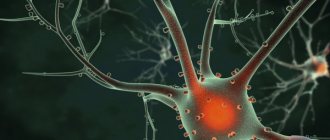Vegetovascular dystonia (VSD) is one of the few syndromes in medicine that causes a lot of disagreement among doctors. There are still no uniform criteria for diagnosis and therapy, so patients have to face many difficulties. Treatment of VSD should begin from the moment you seek medical help, and in modern realities a person has to undergo many examinations. As a result, the patient continues to experience painful symptoms of vegetative-vascular dystonia, and the doctor does not understand how to cure VSD and again sends the patient for further examination. This vicious circle can last from several months to several years.
What is VSD?
To explain the symptoms and treatment of VSD, it is necessary to have an understanding of the regulation of our body’s activities. The functioning of all internal organs is ensured by complex and multi-level relationships between the central and peripheral nervous systems.
The central cord includes the brain and spinal cord. The peripheral nervous system is represented by numerous nerve endings in organs and tissues. Some of them are under the conscious control of a person, for example, if you want to make some kind of movement, an impulse from the brain arrives to the nerve ending in the muscles. This section is called the somatic nervous system.
The other department is vegetative. It is responsible for the work of all internal organs and changes their activity, depending on environmental factors, physical activity of a person or his psycho-emotional status. This part of the nervous system works independently, that is, a person’s volitional efforts are not able to influence its activity.
The autonomic nervous system is responsible for the activity of all internal organs. Moreover, it also consists of two sections: sympathetic and parasympathetic. In their action, they have opposite effects on organs. For example, the sympathetic department increases the contractile activity of the heart, and the parasympathetic department reduces the frequency and strength of heart contractions.
In medicine, the term VSD is understood as a pathological condition when the normal relationship between two parts of the autonomic nervous system is disrupted. There is still no consensus among doctors about this syndrome.
Some clinicians do not consider VSD as a disease, but rather as a reversible pathological process based on dysfunction of the nervous system. At the same time, without timely correction, vegetative-vascular dystonia can develop into a disease of the heart, blood vessels, gastrointestinal tract or nervous system.
Many doctors agree that the syndrome is of a mental nature. All complaints with which the patient comes to the appointment are regarded as psychosomatic, that is, “arising” from mental and emotional disorders.
Despite disagreement about what it is, VSD requires complex treatment. The existing symptoms of vegetative-vascular dystonia have a pronounced negative impact on the condition of patients.
VSD of mixed type
Depending on how the cardiovascular system reacts to a disorder of the autonomic nervous system, the 3 types of VSD described above are conventionally distinguished. But, as a rule, vegetative-vascular dystonia includes several types of symptoms at once.
The mixed type is characterized by a combination of the above symptoms. Blood pressure “jumps”, a person feels sometimes depressed, sometimes irritated, sometimes experiences weakness, sometimes excessive emotional overexcitation, and his mood changes sharply. With a mixed type of VSD, the whole spectrum of symptoms can manifest itself: cardiac and respiratory arrhythmia, panic attacks, pain with vague localization. This type of autonomic disorder is the most common.
Causes and predisposing factors
The causes of VSD remain the subject of debate. These are due to differences in opinion about what the syndrome itself is. A number of doctors perceive vegetative-vascular dystonia as a consequence of diseases of any organs. The appearance of symptoms of vegetative-vascular dystonia is explained by secondary disturbances in nervous regulation against the background of the existing disease. For example, with cardiac manifestations of VSD, the doctor begins to look for pathology of the heart and blood vessels. Failures in finding the disease are explained by incomplete laboratory and instrumental examination of the patient.
Modern medicine is of the opinion that VSD is caused by excessive overload or disturbances in the psycho-emotional sphere. The variety of symptoms that mimic the pathology of internal organs is actually a manifestation of psychological stress. This is confirmed by laboratory and instrumental data. During the examination of the patient, no abnormalities in the internal organs are revealed.
Autonomic dystonia is part of the group of neurotic disorders (neuroses). This group of conditions is determined by the characteristics of the response to stressful situations. At the same time, in a number of patients, the symptoms of VSD (cardiac, gastrointestinal, respiratory) come to the fore and are accompanied by painful experiences.
The psychogenic nature of vegetative-vascular dystonia is also explained by the variety of mental disorders in patients with this diagnosis. Somatic (organ) manifestations are often combined with anxiety-phobic and obsessive-compulsive disorders, depression. When taking a detailed history, patients are found to have had traumatic situations in the past, signs of social maladaptation, family and interpersonal problems.
In addition to psychoemotional disorders, the following factors play a role in the development of VSD:
- hereditary and constitutional features of the autonomic nervous system;
- unfavorable course of pregnancy, childbirth and the early postpartum period;
- diseases of the central nervous system;
- characteristics of the patient’s character and personality;
- hormonal imbalance;
- excess body weight;
- infectious diseases;
- suffered acute and chronic diseases, as well as surgical interventions.
A special place in the causes of vegetative-vascular dystonia is given to lifestyle disorders. Predisposing factors may include a sedentary lifestyle, disturbances in sleep-wake cycles, bad habits, monotonous work, mental and physical stress.
VSD of cerebral type
With vegetative-vascular dystonia of the cerebral type, the tone of the blood vessels in the brain is disturbed. The blood vessels spasm, which leads to disruption of blood supply and nutrition to the brain. Cells lack oxygen, and blood flow deteriorates.
The primary symptoms are headaches, dizziness, blurred vision, noise and pounding in the ears, and nausea. Other symptoms of VSD may also appear: pain in the heart, tachycardia, vascular instability (bouts of heat, sweating, pale skin), difficulty breathing, shortness of breath and a number of other symptoms. According to cardiac rhythmography data, VSD of the cerebral type will be expressed by hyperactivity of waves from the autonomic centers of the brain and, possibly, sympathetic waves.
Kinds
There is still no unified classification of vegetative-vascular dystonia that would take into account the diversity of its manifestations. In medical practice, VSD is most often divided into several types:
- vagotonic – the clinical picture is due to the predominance of the parasympathetic department over the sympathetic one (low blood pressure, chills, dizziness, lightheadedness, “lump in the throat” and others);
- sympathicotonic - symptoms are associated with hyperfunction of the sympathetic department (increased blood pressure, rapid heartbeat, feeling of heat);
- mixed - both types of symptoms may be present in the clinical picture.
Depending on the mechanism of development, the syndrome is divided into two types: primary and secondary. The primary form of VSD occurs independently, the secondary form occurs against the background of existing diseases of various localizations.
Vegetative-vascular dystonia is also divided into subtypes depending on organ symptoms. Here are several clinical variants of VSD:
- changes in the cardiovascular system;
- disruption of the gastrointestinal tract;
- psychoemotional and nervous disorders;
- changes in the functioning of the respiratory system.
The most common VSD involves the cardiovascular system. This type of syndrome has its own name - neurocirculatory dystonia. It is divided into several clinical subtypes.
| Hypertensive | Hypotonic | Cardiac |
| Characterized by increases in systolic blood pressure, palpitations and interruptions in heart function. Combined with other manifestations of sympathicotonia (for example, hot flashes, sweating). | It is characterized by lowering blood pressure and slowing heart rate. Other symptoms include signs of vagotonia (dizziness, fainting, and others). | The main complaint is pain in the heart area of varying nature and severity. Most often, the pain is stabbing and occurs against the background of emotional stress. |
Any of the listed variants of vegetative-vascular dystonia can be of three degrees of severity: mild, moderate or severe. The severity of the condition is assessed based on the client’s complaints and the severity of clinical manifestations.
The course of VSD can be permanent (constant) or paroxysmal (paroxysmal). The first variant of the syndrome is spoken of in cases where the symptoms bother you almost every day and are mild or moderate. A vegetative-vascular attack begins suddenly against the background of the patient’s relative health and is accompanied by a significant deterioration in the general condition. As a rule, an attack is provoked by overwork or psycho-emotional stress.
Clinical manifestations
The whole variety of symptoms of autonomic dysfunction can be divided into several groups. In this case, the organ localization of manifestations of vegetative-vascular dystonia is taken into account.
Cardiovascular manifestations
Cardiovascular symptoms in adults and children are very common with VSD. The main ones are cardialgia (pain in the heart) and various rhythm disturbances. Most often, heart pain appears suddenly against the background of previous emotional stress, less often they are observed at rest. They have a stabbing character. Patients themselves usually describe the pain syndrome with the phrase “stabbing like needles,” pointing to the area of the heart.
The duration of pain varies. For some it is a single tingling sensation, for others it is a long-term discomfort. The pain can also radiate to the shoulder girdle, left arm or shoulder blade, and less commonly to the right half of the body. Such symptoms sometimes cause suspicion among doctors due to the similarity of clinical manifestations with coronary heart disease, in particular with angina pectoris.
Rhythm disturbances are represented by its slowdown or acceleration (brady- and tachycardia). Bradycardia is usually not felt by the patient and is detected during examination. An increased heart rate may be perceived as palpitations. Less common are extrasystoles, which are felt as a “fading” of the heart.
This group of symptoms also includes an increase or decrease in blood pressure (hypertensive and hypotonic type of syndrome). The vascular manifestations of VSD are diverse. They are mainly represented by chilliness and freezing, coldness of the extremities, and pallor of the skin.
The most pronounced cardiovascular signs of vegetative-vascular dystonia are in patients suffering from paroxysms. During an attack, the symptoms sharply worsen, and in addition to them, uncontrollable fear, a feeling of lack of air, and others appear.
Gastrointestinal manifestations
Symptoms of VSD from the digestive organs are varied. They can be combined into two large groups: dyspepsia and irritable bowel syndrome. In the first case, the patient's complaints are presented as follows:
- pain in the projection of the stomach or esophagus of varying intensity, not having a clear relationship with food intake;
- belching air;
- feeling of fullness in the stomach, distension;
- flatulence;
- nausea;
- unpleasant taste in the mouth, often metallic or bitter;
- tendency to diarrhea or constipation.
Such symptoms are similar to manifestations of a peptic ulcer, but when examining the patient, no signs are found. The listed complaints bother patients for a long time, and drug therapy does not provide a lasting effect. Disorders of the gastrointestinal tract often cause a decrease in appetite and body weight.
Another type of disorder with autonomic dystonia is irritable bowel syndrome. Its main manifestations are stool upset and widespread abdominal pain. At the same time, the patient’s appetite does not suffer, and body weight remains the same. Painful sensations can be long-lasting and aching, or acute, paroxysmal (like spasms). Stool disorders are represented by diarrhea (defecation three times a day or more often) or constipation (stool less than three times a week).
Respiratory symptoms
The main respiratory symptoms of VSD are represented by neurogenic respiratory disorders. The respiratory system, although considered autonomous, is still closely connected with the emotional state. Anxiety and low mood play a special role here.
Under the influence of a psychogenic factor, the rhythm of normal breathing is disrupted. It becomes faster and deeper. As a result, hyperventilation develops, which can lead to biochemical changes. A patient with respiratory disorders experiences hypocapnia (lack of CO2 in the blood) and respiratory alkalosis (alkalization of the blood). These shifts can lead to pain and other sensory disturbances, which again triggers breathing failure.
Respiratory disorders may include the following:
- labored breathing;
- feeling of lack of air;
- violation of the frequency and depth of breathing;
- equivalents of hyperventilation (frequent sighs, coughing, yawning).
Respiratory symptoms of VSD are sometimes referred to as “empty breath.” The patient's main complaints are dissatisfaction with inhalation and a feeling of lack of air. The constant feeling of lack of air is manifested not only by deep breaths. Patients do not tolerate hot weather and prolonged stay indoors.
Respiratory disorders are more pronounced in crowded places or during stressful situations. In the paroxysmal form of VSD, respiratory disorders are of the nature of a hyperventilation crisis and are expressed to a significant extent.
Nervous and psychoemotional disorders
This group of symptoms is regarded by most doctors as the main one. Mental and emotional disorders in VSD are most pronounced. They can be represented as follows:
- increased anxiety and constant nervousness;
- lability (swings) of mood, a tendency to decrease;
- various types of phobias (fears), especially social ones;
- panic disorders;
- sleep disorders;
- obsessive thoughts and actions (constant hand washing, checking things);
- non-acceptance of oneself;
- loss of interests and desire to do anything;
- inability to enjoy or take pleasure in anything.
Neurological symptoms also include fainting. They are more often observed in adolescents and young adults. The mechanism of their development is associated with a short-term decrease in cerebral circulation. Fainting can last from a few seconds to several minutes. It is not accompanied by convulsions, and after fainting there may be general weakness and a feeling of weakness.
In most patients, true neurological disorders (primary headaches, neurogenic fainting) or mental illnesses are hidden under the “mask” of VSD. The fact is that the diagnosis of VSD is only a statement of the fact that the patient has some somatic symptoms. The root cause of these complaints remains unknown to general practitioners.
Somatic manifestations of VSD in psychiatry are almost always considered as a consequence of mental disorders, especially the anxiety spectrum. The range of mental disorders that have symptoms of vegetative-vascular dystonia includes depression, anxiety-phobic disorders, mania and neurotic-type syndromes.
Other symptoms
VSD can also manifest itself as thermoregulation disorders. A number of patients may experience a rise in temperature due to emotional stress, more often in the morning. This may be accompanied by a feeling of heat and profuse sweating. Temperature rises are more often observed in the autumn-winter period.
With the vagotonic type of VSD, patients blush easily in stressful situations. The skin has a cyanotic (blue) color, moist and cold. Upon closer examination, a vascular pattern is revealed, giving the skin a marbling appearance.
Vagotonia is also characterized by excessive greasiness of the skin and a tendency to acne. Sympathicotonia, on the contrary, is characterized by dry skin and a tendency to peel. Sweating in patients is scanty.
VSD of cardiac type
In the cardiological (as well as in the hypertensive) form of autonomic dysfunction, the diagnosis will most likely show obvious sympathicotonia, that is, functional tension in the work of the sympathetic department of the ANS. A distinctive feature of VSD of the cardiac type is pain in the heart area (stabbing, pressing or burning sensations in the chest area). Signs may resemble those of an angina attack or myocardial infarction. But upon examination, cardiac pathologies are not detected.
The cardiac type of reaction to a vegetative-vascular disorder is characterized by: tachycardia, cardiac arrhythmia, false pain in the heart area, as well as respiratory arrhythmia and asthma attacks. It is important to understand that with VSD, pain in the heart area is not a harbinger of a heart attack and does not in any way affect the cardiovascular system, which will be confirmed by the patient’s echocardiogram. Cardiac rhythmography is very effective in diagnosing this type of VSD.
Sudden vegetative-vascular attack
The so-called “vegetative-vascular crises”, which in practice occur like panic attacks, deserve special attention. The sudden onset of feelings of fear and anxiety is accompanied by severe somatic symptoms (palpitations, inability to breathe). They are extremely difficult for patients to tolerate and lead to complete social maladjustment. Moreover, a person is constantly in painful anticipation of a second attack.
In some patients, the attack appears suddenly. Others note a clear relationship with potentially threatening or stressful situations. This could be being in society, a cramped room or space, exciting news, etc.
In addition to severe anxiety and fear, the patient experiences palpitations, a lump in the throat, a feeling of lack of air and the inability to breathe. Choking, dizziness, increased heart rate, as well as disorientation in space and time lead to a feeling of fear of death. A panic attack often causes an ambulance to be called.
Treatment methods
Treatment methods for neurocirculatory dystonia depend on the symptoms of the disease. NEARMEDIC specialists, first of all, conduct a thorough examination, identify chronic pathologies and provoking factors. Only then are medications prescribed to normalize heart function, sedatives, and vitamin complexes. Non-drug treatment methods have been successfully used. The appointment of physiotherapeutic procedures, as well as massage, ozone therapy, acupuncture, and water procedures helps to normalize the functioning of the entire body and relieve stress. To normalize the psycho-emotional state, conversations with a psychotherapist or psychologist are recommended.
Diagnostics
The diagnostic program for suspected VSD is to exclude pathology of internal organs, the cervical spine, as well as impaired blood supply to the brain. The scope of the diagnostic program is determined by the attending physician based on the patient’s complaints. As a rule, a simple laboratory and instrumental examination is sufficient. For example, in case of cardiac complaints, an ECG, ultrasound of the heart, daily monitoring of pressure and heart rhythm, and stress tests are performed. For complaints of dizziness and darkening of the eyes, a duplex of the vessels of the head and neck, or an MRI of the brain in vascular mode. In many cases, a consultation with a psychotherapist is recommended, especially if no violations of the internal organs or the central or peripheral nervous system are detected.
Osteopathic diagnosis plays an important role. It allows you to identify those disorders that are “not visible” during instrumental examination. Often, the patient is referred to a psychotherapist, while the cause is quite “tangible” and can be perfectly treated with osteopathy. Diagnostics is based on the fine sensitivity of the hands of an osteopath and allows you to identify those areas of the body in which tissues are “tight,” move poorly, or affect other areas of the body, disrupting their normal function.
For example, with symptoms such as:
- dizziness, weakness;
- panic attacks;
- difficulty breathing;
- chest pain;
- chronic pain;
- heartbeat;
- high blood pressure;
- arterial hypotension;
- stomach ache.
VSD of vagotonic type
Vagotonia is characterized by a wide variety of symptoms, which can raise suspicion of serious diseases of the heart, endocrine or respiratory system, diseases of the gastrointestinal tract or even the psyche. A thorough examination does not reveal any pathologies in the organs and systems of the body. And as a “diagnosis of exclusion,” the patient is diagnosed with “VVD of the vagotonic type.” Indeed, a variety of symptoms that do not fit into a single pathological process are caused by vagotonia - hypertonicity of the vagus nerve (“vagus”). The vagus nerve regulates the activity of organs, glands and blood vessels, and an increase in its tone causes spasm of smooth muscles throughout all structures of the body.
With this type of VSD, the activity of the parasympathetic part of the nervous system predominates (over the sympathetic), which will be confirmed by the diagnosis of CRH. A person becomes apathetic, unsure of himself, suspicious, suffers from hypochondria, suspecting that he has the most terrible and, perhaps, still unknown disease. Memory for specific things often deteriorates: numbers, dates, details, and mental activity decreases.
Physical symptoms are bradycardia, hypotension, vestibular disorders (dizziness and fainting), fatigue, shortness of breath, pale skin, cold extremities, non-localized pain in the abdomen and chest. Despite the broken state, the person experiences difficulty falling asleep and does not sleep well during the night. In advanced cases, patients experience panic attacks, depression and suicidal tendencies. Symptoms can appear in a complex manner, or they can be localized - when complaints are limited to one of the organ systems. The disease can be chronic or manifest itself in the form of outbreaks, vegetative crises, when the condition sharply worsens. In vagotonic children, the pathology also manifests itself in an abundance of allergic reactions.
Causes of vegetative-vascular dystonia
VSD can develop against the backdrop of a huge number of diverse factors. Among them are especially distinguished:
- psychological – severe or constant stress, depressive states;
- physical – severe physical fatigue, exposure to vibration, high temperatures, sunstroke;
- chemical – addiction to alcohol, nicotine, narcotic substances, taking a number of medications, in particular those containing ephedrine, caffeine, bronchodilators;
- changes in hormonal levels - adolescence, pregnancy and lactation, menopause, use of hormonal contraceptives, especially with frequent periods of withdrawal;
- infectious – acute and chronic diseases of the respiratory system, kidneys, brain;
- neurological disorders - Parkinson's disease, traumatic brain injury;
- endocrine diseases – diabetes mellitus, thyrotoxicosis;
- pathologies of the cardiovascular system - arterial hypertension, coronary artery disease.
It is believed that the main cause of the development of VSD is stress.
But not all people who have even several of the listed diseases develop vegetative-vascular dystonia. Women suffer from it 2 times more often than men, and almost half of all cases of VSD diagnosis occur in young girls who have not yet turned 25 years old. And only 33% of women with vegetative-vascular dystonia are over 25 years old.
Heredity plays a significant role in assessing the risk of VSD. Very often it first appears in childhood or adolescence. As one gets older, the disorder can be compensated and the attacks disappear. But the impact of negative factors can reverse the situation and again provoke the occurrence of vegetative-vascular dystonia.
The impetus for its development can be:
- psychological characteristics of the individual, especially suspiciousness and a tendency towards hypochondria;
- unfavorable socio-economic, environmental conditions (lack of sunlight, sedentary lifestyle, lack of funds, lack of nutritional culture, consumption of cheap, low-quality products, etc.);
- intrauterine pathologies - infections, hypoxia, fetoplacental insufficiency, rhesus conflict, etc.
Sometimes VSD is a transient reaction to any strong emotional shocks or emergency situations.









